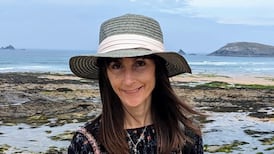When her niece came to visit her in Paris, Lara Marlowe got the chance to rediscover the city through her eyes.
When I was a child I was fascinated by my mother's brass Eiffel Tower. The cheap tourist souvenir led me to believe the world's most famous monument was made of gold; later I would be disappointed. But I still love its elegant lines, the way it stands like a beacon over Paris. The Eiffel Tower is, as Apollinaire wrote, a shepherd watching over a herd of bridges.
So I felt a strengthened kinship with Callie McRee, my 10-year-old niece, when she told me on arriving from California: "I saw the Eiffel Tower from the airplane!" It was the first place she wanted to visit, though at the height of the heatwave it took us three days to get there. Callie, too, was surprised by the dull brown colour. She suggested that it should be painted black, with gold for the rivets.
An irresistible urge to tinker with perfection runs in the family. I had long ceased to notice the black and gold combination on Paris's wrought iron; Callie is enchanted with it.
Six million people visit the Eiffel Tower every year, and from the length of the queue snaking around its base in the 40-degree heat I suspect most of them do so in mid-August. When I finally convinced the staff at the Société Nouvelle d'Exploitation de la Tour Eiffel that I really was going to write about Callie's visit to Paris, they squeezed us into a lift to the second floor. "But what was it supposed to do?" Callie asked of the tower's 1889 construction.
It's worth the few extra euro to take another lift to the third floor for the extraordinary view of the city. There's a replica of Gustave Eiffel's little apartment at the top, where he liked to receive guests, complete with wax mannequins of Eiffel and his friend Thomas Edison. I did not tell Callie and her mother that the third floor had caught fire only three weeks before.
I'd seen the fountains at the Parc André Citroëin south-west Paris many times in photos, but if my niece had not been wilting like an orchid in the Sahara I might not have gone there. The fountains are an ingenious invention: a giant stone slab pocked with hundreds of holes through which icy water regularly spurts. Children in swimsuits put shoes and beach balls over the openings and shriek with pleasure when a surge of water lifts them. But the real delight was being cold. It was the only time I saw Callie grin until the heatwave broke.
When you next visit the Louvre, avoid the queue in the sun outside the glass pyramid by entering through the Carrousel du Louvre shopping mall in the rue de Rivoli.
Callie's common sense was again disarming. Inside the museum, she was horrified by Padiimenipet's 2nd-century BC Egyptian mummy. "But why did they take him out of his tomb?" she kept asking.
Nor did the world's most famous portrait find favour with Callie. "Here's the famous-for-nothing girl," Callie announced as a museum guard shooed the crowd on with the words: "Keep moving. Keep moving." "She's freaky," my niece said of the Mona Lisa. "Her eyes follow you all the time, and her smile shows she's not very friendly." She much preferred animal paintings, especially Delacroix's Tigers.
Most of Callie's dreams of Paris were based on notions she had brought from California; she wanted to see Notre-Dame because she'd bought a replica of a rose window in San Francisco. She wanted her portrait drawn on the Place du Tertre in Montmartre, like her school friend in San Luis Obispo. And she wanted to see the city from a boat on the Seine.
The Bateaux Parisiens offered the least exhorbitant dinner cruise, in a glass-topped boat with spectacular vistas. It was my chance to see Paris through the wonderment of a child. I'd never thought much of Francois Mitterrand's Très Grande Bibliothèque, for example, but Callie thought it was brilliant to build four towers representing open books.
I had kept a surprise for her. Since June, 20,000 light bulbs have twinkled on and off, Christmas-tree-style, on the Eiffel Tower for the first 10 minutes of every hour. Callie was ecstatic. But as our dinner cruise came to a close the symbol of Paris reverted to its normal, yellow night-time lighting. Callie remembered what I had told her about another little girl from California, decades ago. "Look, Aunt Lara," she said. "It really is made of gold."











